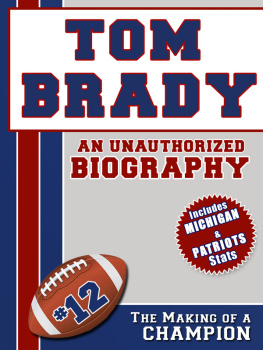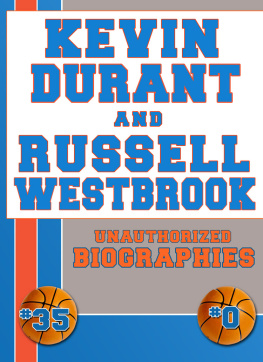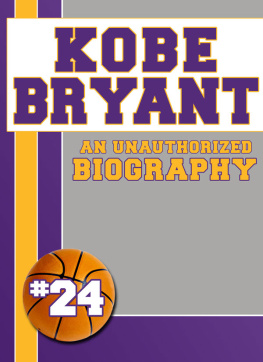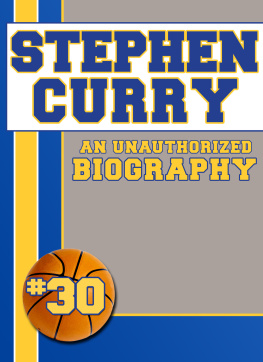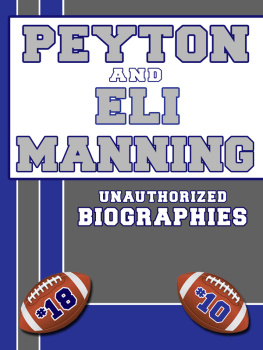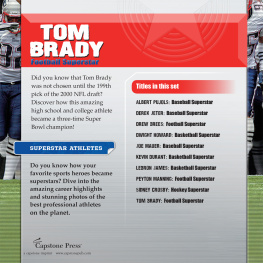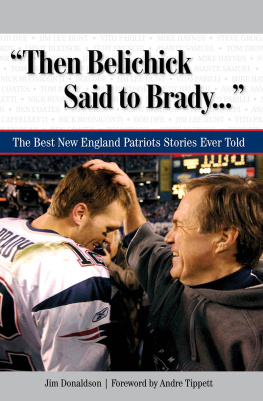Copyright 2012 by Belmont & Belcourt Biographies
All rights reserved. Neither this book nor any parts within it may be sold or reproduced in any form without permission.
eISBN: 9781619840676
The horn announces that time has run out. The game is over. The fourth quarter has once again come too soon for this proven champion. If only there was more time, time to make one last play, time to throw one more pass. Just a little more time.
Confetti falls to the ground like brightly colored leaves tossed by the autumn wind. Autumn-colored leaves signify the end of one season, the advent of another. The multicolored confetti marks the end of Bradys season. Tom Brady sits alone on the field, defeated. The New York Giants rejoice in victory while the New England Patriots suffer the agony of defeat.
As the Giants celebrate with tears, hugs and joyful bliss, Brady, no stranger to victory, picks himself up off the field. As he walks wearily to the locker room, he remembers being in this painful place before. He recognizes what needs to be done to climb out of this dark place in order to once again step up on the podium in celebration once again.
He knows hell return. He knows what needs to be done. He knows he must persevere. He must be determined. He must be patient. He must be champion again.
Humble Beginnings
A lot of times I find that people who are blessed with the most talent dont ever develop that attitude, and the ones who arent blessed in that way are the most competitive and have the biggest heart
-Tom Brady
At 11:48 AM on August 3, 1977, a windy, gloomy day in San Mateo, California, Thomas Edward Brady, Jr. was brought into the world. At the time, nobody realized that this seven-pound two-ounce baby boy would grow into the six-foot four-inch, 225-pound all-star quarterback and celebrity that everyone knows and loves. No, indeed his childhood start would be a very humble one, revealing the true heart of a champion in order to overcome the average sports talents that individuals of his caliber typically possess.
Brady was an avid San Francisco 49ers football fan from a very young age. His father, Tom Brady, Sr., and his mother, Galynn, would take young Tom to 49ers games on a regular basis, loading up the family car and drive thirty minutes north from their affluent San Mateo area to Candlestick Park in San Francisco. One of Bradys earliest and fondest memories of those wonderful times was at the young age of three.
The 49ers were playing in the 1981 NFC Championship game against the Dallas Cowboys. For the entire first half, Tom cried because his parents wouldnt get him a giant foam #1 finger to wave in the stands. He doesnt remember anything else from the first half except for that disappointment. By the second half, the level of excitement was too much for Tom to ignore. Even though he didnt understand everything that was happening on the field, he soon forgot all about the foam finger and focused on the game.
With the fans screaming and cheering, and the feeling of excitement in the air, young Tom knew that something great was happening. He soon zeroed in on one player who seemed to have everyone cheering and yelling his name, Joe Montana. He focused on the Hall of Fame quarterback and watched his every move. When Montana passed to Dwight Clark in the back of the end zone, sending the 49ers to their first Superbowl, the stadium exploded in excitement.
The cheers, the roars, and the ensuing celebrations got Tom thinking, even at that tender age. He imagined how great it would be to be an NFL quarterback like Joe Montana someday. That single come-from-behind victory also bolted the San Francisco 49ers into being known as a powerhouse team. It was the beginning of Joe Montanas path into the Hall of Fame. It was a historical game, and Tom was there to see it.
Brady wasnt what you would consider a born athlete. He didnt have the strength, speed, or agility of any of the other boys. Even on his own block, he was sort of an afterthought when it came to sports. What he did possess, however, none of the other boys could rival. What he owned would eventually serve him well throughout his entire sports career. He had drive, intelligence, determination, persistence, and a natural ability to identify his own weaknesses and correct them. With all of these attributes, evident at an early age and combined with the ability to use them, Brady would eventually propel himself ahead of the pack.
Brady would seek the fastest boy around and challenge him to a foot race. Naturally, he was always beaten, sometimes very badly. But instead of hanging his head and just chalking one up for the other boy, he would analyze his performance, identify what he had done right during the race and what he had done wrong. He would begin practicing to fortify those weaknesses and fine-tune his strengths. Then hed find the same boy and challenge him again, this time with different results. However, Brady wouldnt be satisfied with that victory. He would start looking around for an even faster boy to challenge. Then the process would begin all over again. This is a perfect example of how Bradys work ethic would grow as he got oldernever being satisfied, always trying to improve.
Brady took this same winning determination to the field in youth sports. He excelled in youth baseball as a catcher. The natural gifts that he possessed, not the common sports abilities, such as being fast or strong, made him perfectly suited to be a baseball catcher. His ability to run, catch, throw, and analyze pitchers was second to none. It appeared that he was meant to play baseballa natural, as they say in baseball. Yet, despite his success in youth level baseball, his desire to be a quarterback never faltered.
A freshman at Junipero Sierra High School, he was for the first time part of an organized sports team. In the all-boys Catholic school, which produced such athletes as Barry Bonds and Lynn Swann, Brady made the team as the junior varsity backup quarterback. Even on the bench, he studied the players on the field, always a student of the game. He received his start after the first-string quarterback was injured. That would be the start of a trend that would continue during Bradys football career.
After that first start, replacing his teams injured quarterback, he settled into the starting quarterback role that would last throughout his JV career at school. Playing both baseball and football, Brady became the starter in both sports during his high school junior year. That same year, he became dissatisfied with the teams workout regimen and designed his own, which he would continue to use through high school. One particular jump rope drill was adopted by the entire coaching staff and became a regular part of the teams workout. Only the hard-core players would join Brady for his demanding, sometimes grueling after-school workouts. Brady was truly a coachs dream come truehardworking, honest and dedicated to the game. His work ethic was well known throughout the school.
In his senior year, Brady gained recognition for all his hard work. He was honored in 1994 when mentioned as an All-American in Blue Chip Illustrated and Prep Football Report. All-State and All Far West Performer were also tied to his name. He finished his high school football career with 3,702 passing yards and 31 touchdowns. He was well on his way to a successful football career, just as he had always envisioned.
Brady was still a force to be reckoned with on the baseball diamond. In the 1995 Major League Baseball draft, the Montreal Expos chose him with their eighteenth round pick as a catcher. Brady decided to forego baseball and laid his future in the hands of the National Football League. This choice served him well. The Expos also picked Michael Barrett and Brian Schneider for their catchers, two outstanding ball players who would end up the chosen two for their catcher tandem, although, arguably, Brady might have changed all that. Football, however, was Bradys siren song.
Next page
